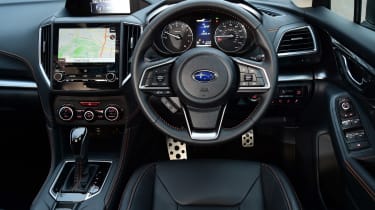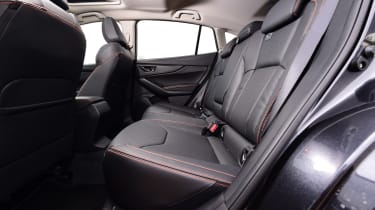Subaru XV review
The Subaru XV is a capable off-roader and it comes with plenty of kit as standard, but it has its limitations

The Subaru XV entered the market in 2012 as an SUV extension of the venerable Impreza, bringing the brand’s Boxer engine philosophy to the straightforward, sanitised and growing world of crossovers.
It’s never been a huge seller in the UK, though Subaru hopes to turn the tide with the new model. The XV has already established itself as the firm’s current breadwinner, and the new, second-generation model seeks to build on the rugged, no-nonsense character and charm of the old model with better on-road dynamics and higher quality.
It sits beneath the Outback estate and Forester SUV in Subaru’s off-road line-up, and rivals everything from the Nissan Qashqai, Skoda Karoq, Mitsubishi Eclipse Cross and SEAT Ateca, while range topping versions are priced within touching distance of entry-level versions of the Audi Q3.
• Subaru XV vs Mitsubishi Eclipse Cross vs Skoda Karoq
The XV line-up is refreshingly straightforward. There are two powertrain choices and two trim levels, both fairly equipped. Both engines are trademark Subaru Boxer flat-four petrols, with a 1.6-litre lining up alongside a more powerful 2.0-litre option. Unconventional CVT transmissions are standard fit, with no option of a manual or regular automatic.
Standard cars are badged SE but Subaru has been generous with the equipment so even these models are well stocked and what we’d recommend. SE Premium cars top out the range, with a little bit of additional equipment and luxury, but not much.
More reviews
Car group tests
In-depth reviews
Road tests
Used car tests
You’ll have to take a second glance to tell old from new due to the tiny design changes, but the second-generation XV is a much-improved car over the firm’s first effort, with a better ride and higher quality interior. It’ll go off road, but its on-road appeal is limited due to the slim engine line-up and CVT transmission.
Engines, performance and drive
With an unconventional approach to powertrain and transmission choices, the XV strikes a different tone on the road to its numerous rivals. The range topping 2.0-litre boxer unit with 154bhp and CVT transmission combination is smooth at lower speeds, but the lack of torque means you’ll have to push the engine into action more often than you’d like.
The real problem here is that the revs rise and hold with the CVT transmission, and above 3,000 the unit loses its refined edge noticeably. Wheel mounted paddles enable the driver to artificially shift the CVT transmission, but it’s not very convincing and doesn’t add any flavour to the driving experience.
The XV’s steering isn’t too bad. The setup itself feels somewhat sharp and ready to react to inputs, but lacks in feel – no great sin in this class. Body control feels good though, thanks to the relative low centre of gravity for a crossover brought about by the low-sitting Boxer unit.
The XV’s ride is okay and its chassis flows nicely, real care seems to have been delivered into the suspension setup to give a composed but cosseted ride. Overall, it’s just a shame that the CVT transmission and lack of torque blots the XV’s copybook from a dynamic point of view.
Unlike many modern cars of this breed, it must be said that the XV will go off-road and can handle surprisingly tough ground. All cars are all-wheel-drive as standard, and also come equipped with Subaru’s X-Mode traction control setup for poor surfaces, and hill descent control. You’ll certainly plough off the beaten track more confidently in the Subaru than in many rivals.
Engines, 0-60 acceleration and top speed
The latest XV drops diesel altogether in favour of two petrol options. Both are traditional Subaru boxer units, the firm favouring the lower vibration and movement of flat engines compared to inline combustion, and also the lower centre of gravity.
The new 1.6-litre develops 112bhp and 150Nm of torque. It’s underpowered for an all-wheel-drive car of this size, with Subaru claiming a lethargic 13.9-second 0-62mph dash and a top speed of 109mph. In any case, we’d recommend the more powerful 2.0-litre. Power steps up to 154bhp, and while 196Nm of torque still lags behind the grunt offered by the XV’s turbocharged rivals it does at least endow the Subaru with a level of performance that’s acceptable. With this engine, 0-62mph takes 10.4 seconds and top speed climbs to 120mph.
With just CVT transmissions offered, the XV’s powertrain has a Jekyll and Hyde personality. When not under strain progress is smooth and refined, but it’s all too easy for the transmission to hold revs under harder acceleration, meaning the Boxer unit loses its cool and fills the cabin with noise.
MPG, CO2 and Running Costs
When equipped with the 2.0-litre engine, Subaru claims that the XV will manage 40.9mpg. Compare that to the 1.0-litre Ateca and the 1.2-litre CH-R - both of which offer similar performance - and it’s 7mpg thirstier than the Toyota and 13.4mpg down on the SEAT. The 1.6-litre ekes out 44.1mpg in official tests, but the pennies saved at the pumps comes at the expense of performance. A 63-litre tank means that, should you match those figures in the real world, a theoretical range of over 600 miles is possible.
The XV will be more to tax than its rivals, too. At 145g/km of CO2, the first-year VED rate for the 1.6 stands at £205. The 2.0-litre emits 155g/km of CO2 resulting in a first year bill of a hefty £515. The equivalent Ateca comes in at £165 for the year.
• Best crossovers and small SUVs
Insurance groups
There’s no particular respite from running costs when it comes to insurance either. A group 15 rating for the 2.0-litre is six groups higher than the equivalent Ateca. However, the smaller 1.6 is a more reasonable group 10.
Depreciation
Residuals are better if you stick to the regular SE models, but at best the XV can hold just under 42 per cent of its value after three years. Compare that to the Toyota CH-R and the SEAT Ateca - both of which hold over half of their value over the same period - and in effect the XV is pricier to run.
Interior, design and technology
From the outside, the XV’s styling hasn’t changed radically from its predecessor, though the subtle changes - to the headlights and front grille, for example - give a shaper, more modern look. A pair of roof rails and bulky plastic cladding around the arches and bumpers help present it as a chunkier alternative to the likes of the Toyota CH-R. Colour options are limited; with only six paint finishes to choose from - one of which is only available with the 2.0-litre engine - there’s far less choice than you’ll get from the majority of rivals. Smaller engined models get 17-inch alloy wheels, while the 2.0-litre models have an extra inch in diameter.
Inside, the XV maintains the exterior’s sturdy theme. The switchgear feels pleasingly solid, and while not all of the surfaces are finished in the sort of soft touch materials you’ll find in a VW Tiguan, it all feels built to last. Though perhaps not as stylish as some rivals, the layout is fairly functional too, but the use of three screens - one between the dials, another for the infotainment system and a third on the top of the dash displaying trip information - seems like overkill. SE models feature fabric upholstery while the SE Premium trim adds full leather.
Sat-nav, stereo and infotainment
Like the rest of the dash, Subaru’s eight-inch touchscreen infotainment setup is well laid out. The home screen has a smartphone-style tile arrangement for the main functions, which combined with the physical shortcut buttons below, make it easy to navigate even for the first time.
You'll need to upgrade to the Premium SE trim to get built-in sat nav, but if you’d rather make use of the systems on your smartphone, both Apple CarPlay and Android Auto are standard across the range. Likewise, all models are fitted with a reversing camera. It’s fairly hi-res so it gives a clear view of what’s behind.
Practicality, comfort and boot space
As with all of its family SUV rivals, the XV is a five-door only. The driver will find it easy enough to make themselves comfy, thanks to a chair and steering wheel with plenty of adjustment.
Size
The XV measures 4,465mm in length, 1,800mm in width and 1,615mm in height. That makes it 18mm longer, 41mm narrower and 9mm lower than the Peugeot 3008. At 2665mm, the Subaru’s wheelbase is 10mm shorter than the Peugeot’s.
Leg room, head room & passenger space
In the back, there’s enough kneeroom for taller passengers, but a sloping roofline means that headroom is tighter than it is in the SEAT Ateca. While the outer seats are fairly sculpted, the central rear passenger will feel more cramped. The middle seat is narrow and firm, and it’s raised up, affecting the limited headroom further.
It’s easy to fit a child seat in the back of the XV, thanks to Isofix fixings that are easy to reach from behind a pair of plastic clips. The rear doors are fairly long, so it’s quite easy to weave a bulky seat into the cabin.
Boot
For it’s overall size, the XV’s boot is disappointingly small. A 385-litre volume is much less than the 510-litre volume you get from an Ateca - a car that’s both shorter and taller. The opening isn’t as wide either, and the load lip at the base is exacerbated by the deep rear bumper which it’ll make it hard to load heavier items.
The seats fold in a 40/60 split expanding the total load space to 1,270 litres. Once the rear bench is folded down, there’s a sizeable hump in the floor which makes it hard to move larger and heavier items towards the front of the space. Only the centre section of the boot floor is carpeted, so loose items could rattle around noisily if they’re not secured fully - something that is easier said than done as the XV’s boot lacks useful cargo hooks or elastic netting.
Reliability and Safety
The XV is loaded with standard safety tech, with all models getting front, side, curtain and knee airbags, plus autonomous emergency braking, lane departure warning and lane-keep assist. As a result, the XV scored the maximum five-star rating when it was tested by Euro NCAP in 2017, with a particularly impressive 94 per cent score in the adult occupant protection category.
The XV was too new to feature in the Driver Power 2018 rankings, so we’re yet to have a definitive impression of its reliability. However, its Outback and Forester stablemates finished 20th and 10th respectively in the 2017 survey. Consider this, and the fact that Subaru finished an impressive fourth place in the 2017 brand listings, and it’s likely that the XV won’t be causing too many headaches with buyers.
Warranty
All XVs come with a five-year/100,000 mile warranty, with the agreement expiring based on whichever number is reached soonest. That’s better than average, with only Kia offering a longer warranty duration. In addition to this, there’s a 12-year anti-corrosion guarantee, three years’ cover against paint defect and a breakdown policy for the same period.
Servicing
Throughout the XV’s range, service intervals run to every 12 months or 12,000 miles - whichever comes first. This is lower than some other manufacturers, so it’s worth keeping in mind if you cover high annual mileages. The service bills vary from dealer to dealer too.
For an alternative review of the latest Subaru XV SUV visit our sister site carbuyer.co.uk











